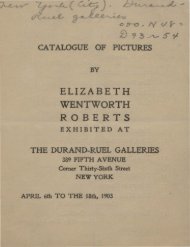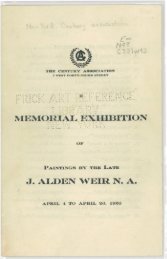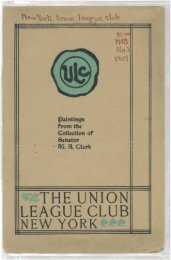Shepherds of the black-headed people - New York Art Resources ...
Shepherds of the black-headed people - New York Art Resources ...
Shepherds of the black-headed people - New York Art Resources ...
- No tags were found...
Create successful ePaper yourself
Turn your PDF publications into a flip-book with our unique Google optimized e-Paper software.
from October 5 th to October 7 th , 2010, submitted contributionsincluded in this volume <strong>of</strong> studies. The individual papers neatly fallinto contributions focusing on <strong>the</strong> third, second and first pre-Christian millennia.For <strong>the</strong> third millennium we were fortunately able to thoroughlydiscuss some topics linked with research on texts, seals andsealings found at <strong>the</strong> Sumerian city <strong>of</strong> Ur in strata datable to <strong>the</strong>early third millennium B.C., with our colleagues from München(Munich), Berlin and Mainz. The scholarly exchange on issues <strong>of</strong> <strong>the</strong>second millennium and especially on <strong>the</strong> demise <strong>of</strong> <strong>the</strong> OldBabylonian state, brought forth remarkable results also thanks to<strong>the</strong> paper by our colleague from Ghent. Finally, <strong>the</strong> first-millennium<strong>the</strong>mes received a most welcome supplement in a review paper on<strong>the</strong> University <strong>of</strong> West Bohemia archaeological exploration <strong>of</strong> <strong>the</strong>huge site <strong>of</strong> Erbil in nor<strong>the</strong>astern Iraq. In <strong>the</strong> last-named case, <strong>the</strong>effort <strong>of</strong> <strong>the</strong> Pilsen scholars enriched our knowledge <strong>of</strong> <strong>the</strong> site bymost welcome information on <strong>the</strong> post-Assyrian history <strong>of</strong> Erbil.How, <strong>the</strong>, can we envisage <strong>the</strong> position <strong>of</strong> <strong>the</strong> Mesopotamian rulersvis-à-vis <strong>the</strong>ir gods and goddesses? This is hardly fitting into <strong>the</strong>popular clichés pertinent to <strong>the</strong> ancient Oriental rulers. Kings andqueens <strong>of</strong> ancient Mesopotamia did not grovel in <strong>the</strong> dust below <strong>the</strong>feet <strong>of</strong> <strong>the</strong>ir deities, slavishly executing what <strong>the</strong>y deemed to havebeen "celestial orders". Nei<strong>the</strong>r, however, can <strong>the</strong>y be likened untoSardanapal <strong>the</strong> tyrant <strong>of</strong> <strong>the</strong> famous painting by Eugène Delacroix,who, when he felt his own death approaching, put to death anddestruction all that belonged to him including his harem. Should wechoose a modern simile that may seem shocking, we propose that<strong>the</strong> relations among <strong>the</strong> Mesopotamian kings, <strong>the</strong>ir subjects and<strong>the</strong>ir deities may be figuratively compared to a soccer match inwhich <strong>the</strong> royal and <strong>the</strong> non-royal sectors <strong>of</strong> Mesopotamian societyrepresent <strong>the</strong> two player teams, while <strong>the</strong> playground and <strong>the</strong> rules<strong>of</strong> <strong>the</strong> game are defined and provided by <strong>the</strong> divinity institutions.Though <strong>the</strong> political courses <strong>of</strong> ancient Mesopotamian states mighthave sometimes led <strong>the</strong>m into dire straits, <strong>the</strong> Sumerians,Babylonians and Assyrians learned well that what had always toremain stable and unmoved, was <strong>the</strong> underlying cultural pattern,<strong>the</strong> "blueprint" on which <strong>the</strong>ir civilization rested, defined, by andlarge, by religion. Much <strong>the</strong> same role was played by religion withrespect to <strong>the</strong> set <strong>of</strong> rules regulating supra-kinship ties withinMesopotamian societies. Bearers <strong>of</strong> <strong>the</strong> ancient Mesopotamiancivilizations felt no need for any <strong>of</strong>fice <strong>of</strong> high priest, a papal curia,or an Inquisition <strong>of</strong>fice, though religious institutions <strong>the</strong>y did know8
















